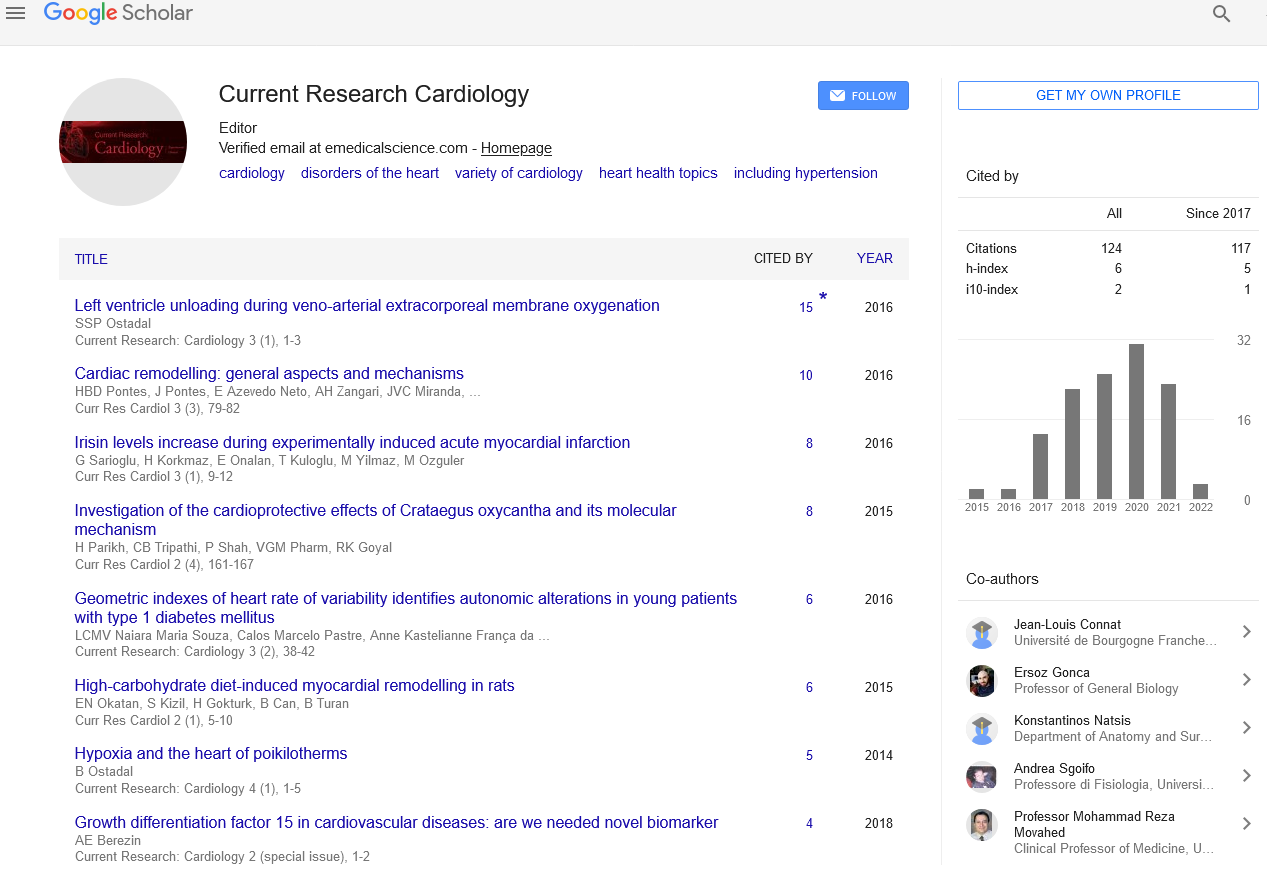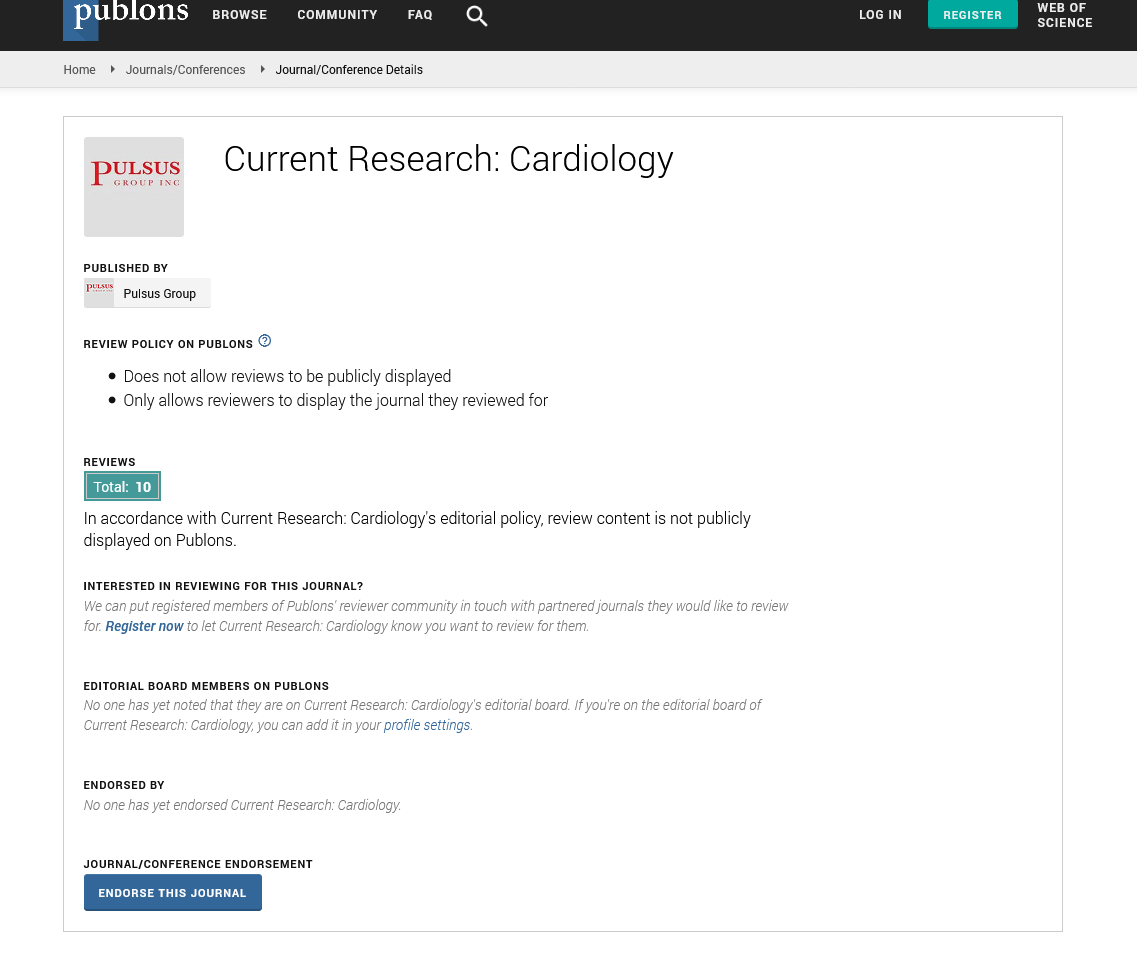Medical tests required for the diagnosis of heart
Received: 02-Dec-2021 Accepted Date: Dec 16, 2021; Published: 23-Dec-2021
Citation: Shaik A. Medical tests required for the diagnosis of heart. Curr Res Cardiol. 2021;8(5):5.
This open-access article is distributed under the terms of the Creative Commons Attribution Non-Commercial License (CC BY-NC) (http://creativecommons.org/licenses/by-nc/4.0/), which permits reuse, distribution and reproduction of the article, provided that the original work is properly cited and the reuse is restricted to noncommercial purposes. For commercial reuse, contact reprints@pulsus.com
About the Study
The medical tests needed to diagnose your heart condition depend on what your doctor thinks the condition is based on the patient's symptoms, risk factors, and medical history. Some of the most common medical tests performed to diagnose heart disease are: Angiography and Coronary angiography. Coronary angiography can be performed during or after a heart attack or angina which sometimes called as a "cardiac catheterization". A catheter (small tube) is inserted into an artery in the groin, arm, or wrist under local anesthesia. The catheter moves up the artery until it reaches the heart.
A special dye is injected into the coronary arteries of the patient and X-rays are taken. It may get hot and flush for a few seconds. X-rays show the doctor where and how narrow the coronary arteries are. It also shows how well your heart is pumping. Coronary angiography helps doctors decide on the best treatment. Sometimes it is best to go straight on to coronary angioplasty while a patient is in the laboratory having a coronary angiogram and the tubes are in place. The cardiologist will discuss this option with a patient before the procedure. Coronary Computed Tomography Angiogram (CCTA): This is a type of Computed Tomography (CT) scan that can help diagnose coronary artery disease. It gives a 3dimensional image of the heart chambers and coronary arteries supplying blood to the heart. A CCTA is a noninvasive test for people who may be experiencing unusual cardiac symptoms.
When a patient's heart muscle is damaged by a heart attack, the body releases substances into the blood. Blood tests can measure the levels of these substances and show if the patient's heart is damaged and how badly it is. The most common test after a heart attack is to check the level of troponin in the blood. Blood tests are also done to measure the levels of other substances in the blood, such as blood fats (such as cholesterol and triglycerides) and minerals. Doctor may have your patient wear a blood pressure monitor 24 hours a day (during daily activities and sleep). This lightweight, portable meter helps doctors get accurate blood pressure information.
Echocardiography performed before and after exercise is also used to identify areas of the heart where the blood supply from the coronary arteries to the heart muscle is reduced. EKG reads the electrical impulses of the heart. Small dots of glue and cables are placed on the patient's chest, arms, and legs.
The leads are connected to the EKG machine, which records the electrical impulses and prints them on paper. Doctors can use EKG to diagnose a heart attack or abnormal heart rhythm. Electrophysiological studies use computers to find abnormal heartbeats (arrhythmias). A special tube (catheter) is inserted into the patient's heart through a vein in the leg. The catheter records the electrical activity of the heart and tests the heart's response to various stimuli.
The electrical response of the heart to these stimuli helps doctors identify the nature and cause of arrhythmias. MRI uses very powerful magnets and radio waves to create detailed images of the heart on a computer. This is not radiation; you will mainly notice the sound of drums as the scan progresses. Special dyes may be used to make parts of the heart and coronary arteries easier to see.
This test shows your doctor the structure of your heart and how well it works, allowing them to determine the best treatment. Stress tests help doctors know how well their heart is functioning when they are physically active using exercise equipment.
Includes exercise test, stress echocardiography and nuclear heart stress test, Doctors use tilt tests to determine if different body positions cause abnormal heartbeats (arrhythmias). It is especially useful for examining the minds of those who faint without explanation.






